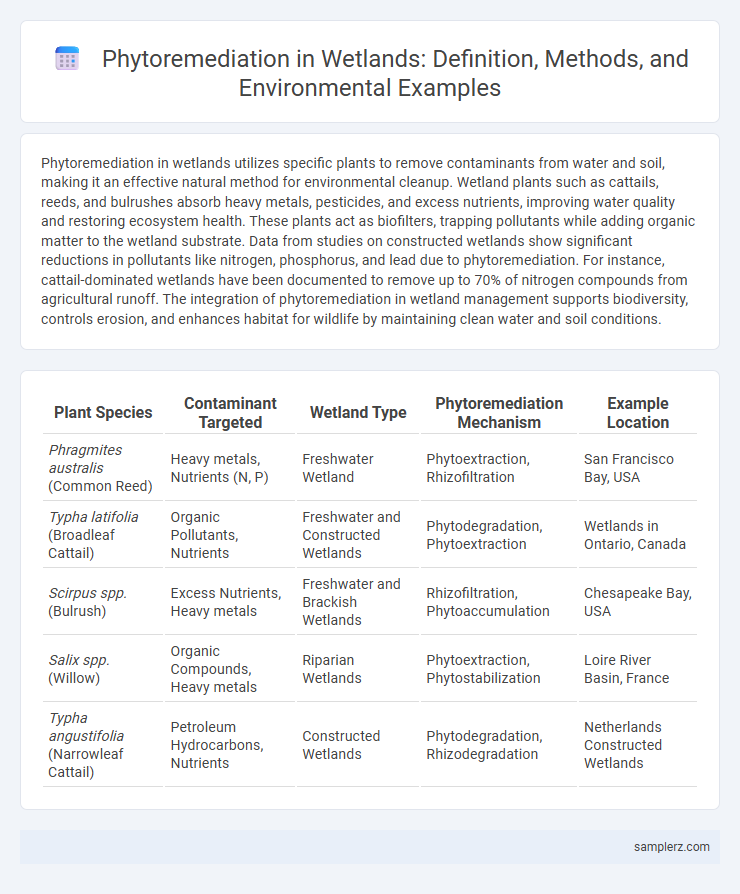Phytoremediation in wetlands utilizes specific plants to remove contaminants from water and soil, making it an effective natural method for environmental cleanup. Wetland plants such as cattails, reeds, and bulrushes absorb heavy metals, pesticides, and excess nutrients, improving water quality and restoring ecosystem health. These plants act as biofilters, trapping pollutants while adding organic matter to the wetland substrate. Data from studies on constructed wetlands show significant reductions in pollutants like nitrogen, phosphorus, and lead due to phytoremediation. For instance, cattail-dominated wetlands have been documented to remove up to 70% of nitrogen compounds from agricultural runoff. The integration of phytoremediation in wetland management supports biodiversity, controls erosion, and enhances habitat for wildlife by maintaining clean water and soil conditions.
Table of Comparison
| Plant Species | Contaminant Targeted | Wetland Type | Phytoremediation Mechanism | Example Location |
|---|---|---|---|---|
| Phragmites australis (Common Reed) | Heavy metals, Nutrients (N, P) | Freshwater Wetland | Phytoextraction, Rhizofiltration | San Francisco Bay, USA |
| Typha latifolia (Broadleaf Cattail) | Organic Pollutants, Nutrients | Freshwater and Constructed Wetlands | Phytodegradation, Phytoextraction | Wetlands in Ontario, Canada |
| Scirpus spp. (Bulrush) | Excess Nutrients, Heavy metals | Freshwater and Brackish Wetlands | Rhizofiltration, Phytoaccumulation | Chesapeake Bay, USA |
| Salix spp. (Willow) | Organic Compounds, Heavy metals | Riparian Wetlands | Phytoextraction, Phytostabilization | Loire River Basin, France |
| Typha angustifolia (Narrowleaf Cattail) | Petroleum Hydrocarbons, Nutrients | Constructed Wetlands | Phytodegradation, Rhizodegradation | Netherlands Constructed Wetlands |
Introduction to Phytoremediation in Wetland Ecosystems
Phytoremediation in wetland ecosystems leverages plants such as Typha latifolia (cattails) and Phragmites australis (common reed) to absorb, transform, or immobilize contaminants from water and sediment. These halophyte and hydrophyte species play a vital role in removing heavy metals, nutrients, and organic pollutants, improving water quality and restoring ecological balance. Wetland phytoremediation offers a sustainable, cost-effective solution for mitigating pollution in aquatic environments by harnessing natural biological processes.
Key Plant Species Used for Wetland Phytoremediation
Cattails (Typha latifolia), bulrushes (Schoenoplectus spp.), and reeds (Phragmites australis) are key plant species used in wetland phytoremediation due to their ability to absorb and accumulate heavy metals and organic pollutants. These hydrophytic plants enhance contaminant degradation through extensive root systems that facilitate microbial activity and nutrient cycling. Their robust growth in saturated soils makes them effective natural biofilters for wastewater treatment and habitat restoration in polluted wetland environments.
Mechanisms of Contaminant Removal in Wetland Plants
Wetland plants such as Phragmites australis and Typha latifolia enhance contaminant removal through mechanisms including phytoextraction, phytodegradation, and rhizofiltration. These species absorb heavy metals and organic pollutants from water and sediments, storing or metabolizing harmful compounds within their tissues. Root-mediated microbial interactions further promote biodegradation of contaminants, improving overall water quality in wetland ecosystems.
Case Study: Heavy Metal Removal in Constructed Wetlands
Constructed wetlands effectively utilize phytoremediation to remove heavy metals such as lead, cadmium, and arsenic from contaminated water sources. Hyperaccumulator plants like Typha latifolia and Phragmites australis absorb and stabilize these toxic metals, reducing their concentration in the environment. This sustainable treatment method enhances water quality and supports ecosystem restoration in polluted wetland areas.
Role of Aquatic Plants in Nutrient Uptake and Water Quality Improvement
Aquatic plants such as cattails (Typha spp.) and bulrushes (Schoenoplectus spp.) play a crucial role in phytoremediation by absorbing excess nutrients like nitrogen and phosphorus from wetland waters, thereby reducing eutrophication. These plants enhance water quality by stabilizing sediments and promoting microbial communities that degrade pollutants. Their extensive root systems also facilitate the filtration of contaminants, contributing to the restoration of wetland ecosystems.
Phytoremediation of Organic Pollutants in Wetland Environments
Phytoremediation in wetland environments effectively targets organic pollutants such as pesticides, polycyclic aromatic hydrocarbons (PAHs), and industrial solvents through plant uptake and microbial degradation. Wetland plants like Phragmites australis and Typha latifolia facilitate the breakdown of these contaminants by enhancing rhizosphere microbial activity and promoting enzymatic degradation pathways. This natural remediation process reduces pollutant bioavailability and mitigates toxicity, improving water quality and ecosystem health in contaminated wetland sites.
Wetland Restoration Projects Utilizing Phytoremediation Techniques
Wetland restoration projects frequently utilize phytoremediation techniques by planting native wetland vegetation such as cattails (Typha spp.) and bulrushes (Schoenoplectus spp.) to absorb and detoxify heavy metals and excess nutrients from contaminated water. These plants enhance sediment stabilization and improve water quality by facilitating the bioaccumulation and breakdown of pollutants like nitrogen, phosphorus, and hydrocarbons. Successful initiatives in the Mississippi River Delta and Chesapeake Bay have demonstrated significant reductions in nutrient loads and improved ecosystem health through these phytoremediation strategies.
Advantages and Challenges of Using Wetlands for Phytoremediation
Wetlands effectively remove pollutants such as heavy metals and nutrients through phytoremediation, leveraging native plants like cattails and bulrushes that enhance water quality and biodiversity. This natural treatment process reduces costs and avoids chemical use, providing habitat benefits and supporting ecosystem services. Challenges include seasonal variability affecting plant growth, potential bioaccumulation of toxins, and the need for careful management to prevent invasive species and maintain wetland health.
Monitoring and Assessment of Wetland Phytoremediation Success
Monitoring wetland phytoremediation success involves tracking the reduction of pollutants such as heavy metals and nitrates through periodic water and soil sampling. Vegetation health and biomass accumulation indicate effective contaminant uptake by plants like Typha latifolia and Phragmites australis. Remote sensing technologies and bioindicator species assessments are critical tools for evaluating ecosystem recovery and long-term sustainability.
Future Prospects for Phytoremediation Applications in Wetland Conservation
Phytoremediation in wetlands demonstrates significant potential for future environmental restoration by utilizing plants such as Phragmites australis and Typha latifolia to remove heavy metals and organic pollutants from water. Emerging research on genetically enhanced wetland species and microbial-plant interactions aims to boost contaminant uptake efficiency and resilience against climate change stressors. Integrating phytoremediation with innovative wetland management practices offers promising pathways for sustainable ecosystem conservation and water quality improvement.

example of phytoremediation in wetland Infographic
 samplerz.com
samplerz.com